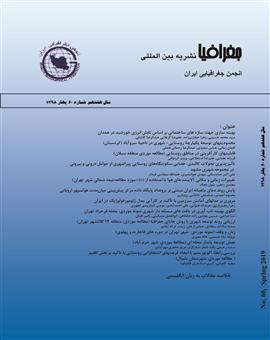سنجش توسعه ی پایدار محله ای (مطالعه ی موردی : شهر خرم آباد)
محورهای موضوعی :سمیه رحیمی یکتا 1 , اصغر شکرگزار 2 , مریم جعفری مهرآبادی 3
1 - دانشگاه گیلان
2 - دانشگاه گیلان
3 - دانشگاه گیلان
کلید واژه: محله, توسعه¬, پایدار, توسعه پایدار شهری, توسعه¬, پایدار محله ای , خرم¬, آباد,
چکیده مقاله :
تحلیل پایداری و وضعیت شاخصهای پایداری در سطح محله های شهری به عنوان رهیافتی جهت دستیابی به توسعه پایدار شهری همواره یکی از اهداف مدیران شهری بوده است. بر این اساس هدف از این پژوهش بررسی وضعیت توسعه پایدار محله ای در سطح محلات شهر خرم آباد و به طور کلی شناخت وضعیت متفاوت بین محلات و نشان دادن سطوح مختلف محلات از نظر شاخصهای توسعه پایدار محله ای بوده است. با توجه به نتایج حاصل از آزمون آنوا، در همه ی شاخص های توسعه ی پایدار محله ای (شاخص اجتماعی ـ فرهنگی، اقتصادی، زیست محیطی، کالبدی)،بین محلات مورد بررسی از نظر تفاوت میانگینها اختلافات معنادار است به عبارت دیگر در سطح معناداری آزمون فیشر برای هرچهار شاخص برابر با 0/000 میباشد و در سطح اطمینان 95/0 درصد کوچکتر از 05/0 است بنابراین تفاوت معنی داری از نظر میانگین بین گروهها وجود دارد و همه محلات از نظر این شاخص ها در وضعیت متفاوتی قرار دارد. همچنین به منظور پاسخگویی به سوال پژوهش وجهت تعیین سطوح همگن توسعه پایدار محله ای و رتبه بندی محلات از نظر سطح برخورداری از شاخصهای توسعه ی پایدار محله ای از نتایج تحلیل خوشه ای و آزمون توکی استفاده شده است.بر اساس نتایج حاصل از آن محله شیرخوارگاه دارای توسعه ی پایدار محله ای بالا در سطح 3 (پایدار)، محله های ساحلی خواجوی، تفکیکی دلفان، شهدا، فازیک، علوی دارای توسعه پایدار محله ای متوسط در سطح 2(نیمه پایدار) ، محله کرگانه، اسپستان شرقی و گل سفید دارای توسعه پایدار محله ای پایین در سطح 1 (ناپایدار) در محدوده مورد مطالعه میباشند.
Sustainability analysis and the status of sustainability indices in urban areas have always been one of the objectives of urban managers as a way to achieve urban sustainability. Accordingly, the aim of this study was to investigate the status of sustainable development of the neighborhood in the neighborhoods of Khorramabad city and in general, to understand the different situation between neighborhoods and to show different levels of neighborhoods in terms of indices of regional development. According to the results of Anova test, in all indicators of sustainable development of the neighborhood (socio-cultural, economic, environmental, physical), there are significant differences between the studied neighborhoods in terms of mean differences. In other words, Fisher's test for each of the four indicators is equal to 0/000 and the confidence level is 0.95% smaller than 0.05. Therefore, there is a significant difference between the groups in terms of average, and all the neighborhoods in terms of this index The situation is different. Also, in order to answer the research question and to determine the homogeneous levels of neighborhood development and ranking of neighborhoods in terms of the level of sustainable development indices, the cluster analysis and Tukey test have been used. The results of that neighborhood have a stable development of the high neighborhood in the 3rd level (sustainable), Khajavi coastal districts, Delphan, Shahid, Phazik, Alawi districts with medium-level neighborhood development at Level 2 (semi-sustainable ), Keghaneh neighborhood, Eastern spain, and white flowers have a low-lying neighborhood development at level 1 (unstable) within the study area.
